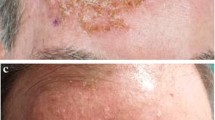Abstract
Background and Objectives
Ingenol disoxate (LEO 43204) is a field therapy in development for the treatment of actinic keratosis (AK) on areas between 25 and 250 cm2. We evaluated the systemic exposure and safety of ingenol disoxate under maximum-use conditions.
Methods
This was a phase I, open-label, non-randomized, multicenter trial. Patients ≥ 18 years of age with ≥ 15 clinically typical, visible, discrete AK lesions in a treatment area on the full face or approximately 250 cm2 on the arm or scalp were treated once-daily for 3 consecutive days with ingenol disoxate 0.018, 0.1, or 0.037% gel, respectively.
Results
The trial included 58 patients. Median age (range) of patients was 68 years (42–89) [face, N = 18], 66 years (43–88) [arm, N = 21], and 67 years (37–83) [scalp, N = 19]. The highest quantifiable ingenol disoxate level was observed in the arm group (0.33 nM, area under the concentration–time curve from time zero to the last data point [AUCtlast] 3.12 nM·h). Mean composite local skin response scores peaked at Day 4 and declined towards baseline by Day 15 in all treatment groups. Most adverse events (AEs) were of mild or moderate intensity; the most common treatment-related AEs were application-site pain (face, 88.9%; arm, 57.1%; scalp, 100.0%) and application-site pruritus (face, 50.0%; arm, 52.4%; scalp, 42.1%).
Conclusion
Very low systemic exposure to ingenol disoxate was observed when applied to the face, arm, or scalp in patients with AK under maximum-use conditions. No new safety signals were identified.
Trial registration
NCT02424305.



Similar content being viewed by others
References
Rigel DS, Stein Gold LF. The importance of early diagnosis and treatment of actinic keratosis. J Am Acad Dermatol. 2013;68(1 Suppl 1):S20–7.
Glogau RG. The risk of progression to invasive disease. J Am Acad Dermatol. 2000;42(1):S23–4.
Malvehy J. A new vision of actinic keratosis beyond visible clinical lesions. J Eur Acad Dermatol Venereol. 2015;29(Suppl 1):3–8.
Ceilley RI, Jorizzo JL. Current issues in the management of actinic keratosis. J Am Acad Dermatol. 2013;68(1 Suppl 1):S28–38.
LEO Pharma. Picato® (ingenol mebutate) gel, 0.015%, 0.05%. Prescribing information. 2015 [cited 10 August 2015]; https://www.picato.com/_pdf/PrescribingInformation.pdf. Accessed 20 Feb 2017.
Lebwohl M, Swanson N, Anderson LL, Melgaard A, Xu Z, Berman B. Ingenol mebutate gel for actinic keratosis. N Engl J Med. 2012;366(11):1010–9.
Bertelsen M, Stahlhut M, Grue-Sorensen G, Liang X, Christensen GB, Skak K, et al. Ingenol disoxate: a novel 4-isoxazolecarboxylate ester of ingenol with improved properties for treatment of actinic keratosis and other non-melanoma skin cancers. Dermatol Ther (Heidelb). 2016;6(4):599–626.
Bourcier M, Stein Gold L, Guenther L, Andreassen CM, Selmer J, Goldenberg G. A dose-finding trial with a novel ingenol derivative (ingenol disoxate: LEO 43204) for field treatment of actinic keratosis on full face or 250 cm2 on the chest. J Dermatol Treat. 2017;28(7):652–8.
Weiss J, Ulrich M, Bukhalo M, Osterdal ML, Bang B, Hanke CW. A seamless phase I/II dose-finding trial assessing ingenol disoxate (LEO 43204) for field treatment of actinic keratosis on the scalp. Br J Dermatol. 2017;176(6):1456–64.
Rosen R, Marmur E, Anderson L, Welburn P, Katsamas J. A new, objective, quantitative scale for measuring local skin responses following topical actinic keratosis therapy with ingenol mebutate. Dermatol Ther (Heidelb). 2014;4(2):207–19.
Bucko AD, Jarratt M, Stough DB, Kyhl L, Villumsen J, Hall A. Pharmacokinetics of ingenol mebutate gel under maximum use conditions in large treatment areas. J Dermatolog Treat. Epub 25 May 2017. https://doi.org/10.1080/09546634.2017.1329506.
Anderson L, Jarrett M, Schmieder G, Schumack S, Katsamas J, Welburn P. Tolerability and pharmacokinetics of ingenol mebutate 0.05% gel applied to treatment areas up to 100 cm2 on the forearm(s) of patients with actinic keratosis. J Clin Aesthet Dermatol. 2014;7(12):19–29.
Stockfleth E, Peris K, Guillen C, Cerio R, Basset-Seguin N, Foley P, et al. A consensus approach to improving patient adherence and persistence with topical treatment for actinic keratosis. Int J Dermatol. 2015;54:509–15.
Acknowledgements
The authors would like to acknowledge Alexandra Webster, MSc, of iMed Comms, an Ashfield Company, part of UDG Healthcare plc, for medical writing support that was funded by LEO Pharma in accordance with Good Publication Practice (GPP3) guidelines. The authors would also like to thank Dr Hala Koudsi as a Principal Investigator in the trial.
Author information
Authors and Affiliations
Contributions
Edward Lain: Implementation of the trial, manuscript writing and review. Torsten Skov: Design of the trial, protocol writing, manuscript writing and review. Anders Hall: Pharmacokinetic design, evaluation and interpretation; manuscript writing and review.
Corresponding author
Ethics declarations
The clinical trial protocol and any relevant amendments to the clinical trial protocol were approved by/received favorable opinion from the relevant Institutional Review Boards prior to the enrolment of patients. This clinical trial was conducted in accordance with the revision, current at the start of the trial, of the World Medical Association’s Declaration of Helsinki—Ethical Principles for Medical Research Involving Human Subjects.
Conflict of interest
Edward Lain has received consulting fees or honorarium from LEO Pharma and Gage Pharmaceuticals. Torsten Skov and Anders Hall are employees of LEO Pharma A/S.
Informed consent
All patients received written and verbal information regarding the clinical trial. The patient’s signed and dated informed consent to participate in the clinical trial was obtained prior to any trial-related activities being carried out in accordance with the International Conference on Harmonization.
Funding
This study was funded by LEO Pharma.
Role of the sponsor
LEO Pharma was involved in the design and conduct of the trial; collection, management, analysis, and interpretation of data; preparation, review, and approval of the manuscript; and decision to submit the manuscript for publication.
Rights and permissions
About this article
Cite this article
Lain, E., Skov, T. & Hall, A. Pharmacokinetics and Safety of Ingenol Disoxate Gel Administered Under Maximum-Use Conditions to Patients With Actinic Keratosis. Clin Drug Investig 38, 249–257 (2018). https://doi.org/10.1007/s40261-017-0608-y
Published:
Issue Date:
DOI: https://doi.org/10.1007/s40261-017-0608-y



